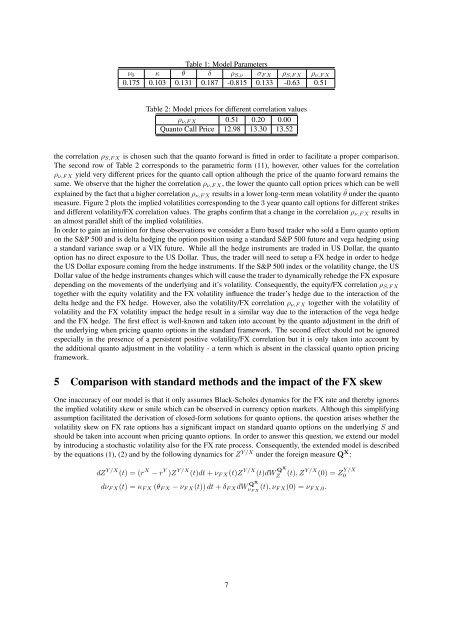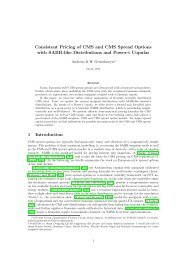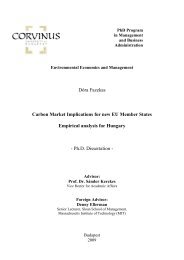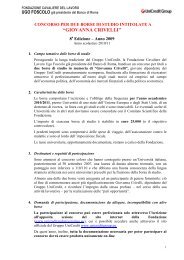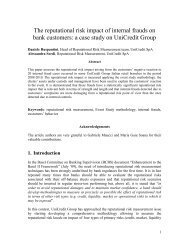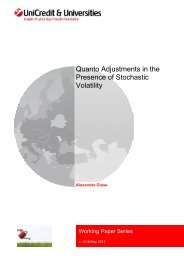Quanto Adjustments in the Presence of Stochastic Volatility
Quanto Adjustments in the Presence of Stochastic Volatility
Quanto Adjustments in the Presence of Stochastic Volatility
Create successful ePaper yourself
Turn your PDF publications into a flip-book with our unique Google optimized e-Paper software.
Table 1: Model Parameters<br />
ν0 κ θ δ ρS,ν σF X ρS,F X ρν,F X<br />
0.175 0.103 0.131 0.187 -0.815 0.133 -0.63 0.51<br />
Table 2: Model prices for different correlation values<br />
ρν,F X 0.51 0.20 0.00<br />
<strong>Quanto</strong> Call Price 12.98 13.30 13.52<br />
<strong>the</strong> correlation ρS,F X is chosen such that <strong>the</strong> quanto forward is fitted <strong>in</strong> order to facilitate a proper comparison.<br />
The second row <strong>of</strong> Table 2 corresponds to <strong>the</strong> parametric form (11), however, o<strong>the</strong>r values for <strong>the</strong> correlation<br />
ρν,F X yield very different prices for <strong>the</strong> quanto call option although <strong>the</strong> price <strong>of</strong> <strong>the</strong> quanto forward rema<strong>in</strong>s <strong>the</strong><br />
same. We observe that <strong>the</strong> higher <strong>the</strong> correlation ρν,F X, <strong>the</strong> lower <strong>the</strong> quanto call option prices which can be well<br />
expla<strong>in</strong>ed by <strong>the</strong> fact that a higher correlation ρν,F X results <strong>in</strong> a lower long-term mean volatility ˆ θ under <strong>the</strong> quanto<br />
measure. Figure 2 plots <strong>the</strong> implied volatilities correspond<strong>in</strong>g to <strong>the</strong> 3 year quanto call options for different strikes<br />
and different volatility/FX correlation values. The graphs confirm that a change <strong>in</strong> <strong>the</strong> correlation ρν,F X results <strong>in</strong><br />
an almost parallel shift <strong>of</strong> <strong>the</strong> implied volatilities.<br />
In order to ga<strong>in</strong> an <strong>in</strong>tuition for <strong>the</strong>se observations we consider a Euro based trader who sold a Euro quanto option<br />
on <strong>the</strong> S&P 500 and is delta hedg<strong>in</strong>g <strong>the</strong> option position us<strong>in</strong>g a standard S&P 500 future and vega hedg<strong>in</strong>g us<strong>in</strong>g<br />
a standard variance swap or a VIX future. While all <strong>the</strong> hedge <strong>in</strong>struments are traded <strong>in</strong> US Dollar, <strong>the</strong> quanto<br />
option has no direct exposure to <strong>the</strong> US Dollar. Thus, <strong>the</strong> trader will need to setup a FX hedge <strong>in</strong> order to hedge<br />
<strong>the</strong> US Dollar exposure com<strong>in</strong>g from <strong>the</strong> hedge <strong>in</strong>struments. If <strong>the</strong> S&P 500 <strong>in</strong>dex or <strong>the</strong> volatility change, <strong>the</strong> US<br />
Dollar value <strong>of</strong> <strong>the</strong> hedge <strong>in</strong>struments changes which will cause <strong>the</strong> trader to dynamically rehedge <strong>the</strong> FX exposure<br />
depend<strong>in</strong>g on <strong>the</strong> movements <strong>of</strong> <strong>the</strong> underly<strong>in</strong>g and it’s volatility. Consequently, <strong>the</strong> equity/FX correlation ρS,F X<br />
toge<strong>the</strong>r with <strong>the</strong> equity volatility and <strong>the</strong> FX volatility <strong>in</strong>fluence <strong>the</strong> trader’s hedge due to <strong>the</strong> <strong>in</strong>teraction <strong>of</strong> <strong>the</strong><br />
delta hedge and <strong>the</strong> FX hedge. However, also <strong>the</strong> volatility/FX correlation ρν,F X toge<strong>the</strong>r with <strong>the</strong> volatility <strong>of</strong><br />
volatility and <strong>the</strong> FX volatility impact <strong>the</strong> hedge result <strong>in</strong> a similar way due to <strong>the</strong> <strong>in</strong>teraction <strong>of</strong> <strong>the</strong> vega hedge<br />
and <strong>the</strong> FX hedge. The first effect is well-known and taken <strong>in</strong>to account by <strong>the</strong> quanto adjustment <strong>in</strong> <strong>the</strong> drift <strong>of</strong><br />
<strong>the</strong> underly<strong>in</strong>g when pric<strong>in</strong>g quanto options <strong>in</strong> <strong>the</strong> standard framework. The second effect should not be ignored<br />
especially <strong>in</strong> <strong>the</strong> presence <strong>of</strong> a persistent positive volatility/FX correlation but it is only taken <strong>in</strong>to account by<br />
<strong>the</strong> additional quanto adjustment <strong>in</strong> <strong>the</strong> volatility - a term which is absent <strong>in</strong> <strong>the</strong> classical quanto option pric<strong>in</strong>g<br />
framework.<br />
5 Comparison with standard methods and <strong>the</strong> impact <strong>of</strong> <strong>the</strong> FX skew<br />
One <strong>in</strong>accuracy <strong>of</strong> our model is that it only assumes Black-Scholes dynamics for <strong>the</strong> FX rate and <strong>the</strong>reby ignores<br />
<strong>the</strong> implied volatility skew or smile which can be observed <strong>in</strong> currency option markets. Although this simplify<strong>in</strong>g<br />
assumption facilitated <strong>the</strong> derivation <strong>of</strong> closed-form solutions for quanto options, <strong>the</strong> question arises whe<strong>the</strong>r <strong>the</strong><br />
volatility skew on FX rate options has a significant impact on standard quanto options on <strong>the</strong> underly<strong>in</strong>g S and<br />
should be taken <strong>in</strong>to account when pric<strong>in</strong>g quanto options. In order to answer this question, we extend our model<br />
by <strong>in</strong>troduc<strong>in</strong>g a stochastic volatility also for <strong>the</strong> FX rate process. Consequently, <strong>the</strong> extended model is described<br />
by <strong>the</strong> equations (1), (2) and by <strong>the</strong> follow<strong>in</strong>g dynamics for Z Y/X under <strong>the</strong> foreign measure Q X :<br />
dZ Y/X (t) = (r X − r Y )Z Y/X (t)dt + νF X(t)Z Y/X (t)dW QX<br />
Z (t), ZY/X (0) = Z Y/X<br />
0<br />
dνF X(t) = κF X (θF X − νF X(t)) dt + δF XdW QX<br />
νF X (t), νF X(0) = νF X,0.<br />
7


